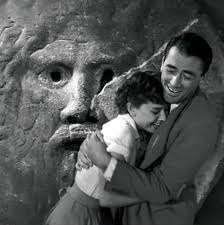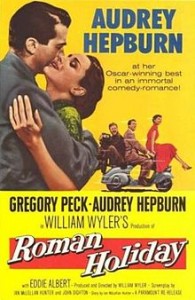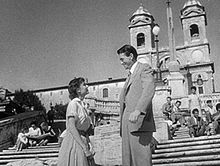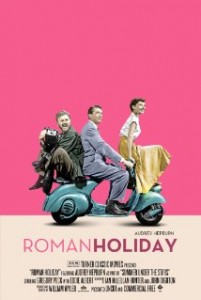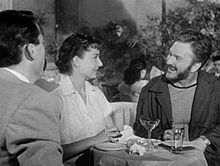Roman Holiday ***** (1953, Gregory Peck, Audrey Hepburn) – Classic Movie Review 44
This delicious 1953 triple-Oscar-winning confection, restored and reissued for its 60th anniversary in 2013, stars Gregory Peck but now is better known as a beloved Audrey Hepburn classic. She’s credited after the title as ‘introducing Audrey Hepburn’, but her immensely cute and appealing performance rocketed to her to international stardom and gained her a Best Actress Oscar and Bafta award as Princess Ann (aka Anya ‘Smitty’ Smith), an alluring young European princess visiting Rome on a good-will tour of the continent’s capitals.
Bored and tired out by endlessly greeting visiting dignitaries and locked up in a palace overnight after being given drugs to calm her by the royal doctor, she flees the building, jumps onto the back of a delivery truck, leaps off in the centre of town and falls asleep on the Via dei Fori Imperiali . She’s found on a bench there by an extraordinarily nice, extremely good-natured American reporter, Joe Bradley (Peck) who thinks she’s drunk, takes pity on her and finally, reluctantly, takes her to his humble home (‘is this an elevator?) where she uses bed instead of the couch he offers.
In the morning, Joe’s got to go to his work, but he’s incredibly late, and, having lied that he’s attended the Princess’s press conference that morning, agrees with his angry boss to write an exclusive interview with the Princess, with pictures to be taken by Joe’s bearded sidekick, news photographer Eddie Albert. Joe returns to the Princess and offers to show her fun in Rome for a 24-hour spree.
Continuing to evade her palace guardians, who’ve covered her disappearance by announcing she’s ill, and the henchmen they send to get her back, the Princess gets her hair cut short and sets off with Joe to get a sweet taste of everyday happy, bustling life in Italy and of course falls in love with Joe.
It’s a delightful, captivating romantic comedy with an extremely witty and appealing Oscar-nominated screenplay and Oscar-winning story, amiably directed by William Wyler, who was clearly in love with both his stars and the streets, sights and people of Rome. He could perhaps have made it slightly snappier and faster and shorter (it’s 118 minutes), but that might have squeezed the charm from it. It’s more or less right as it is.
The film works on one level just as a travelogue of the city as it was 60 years ago, and it’s fascinating just for that. It’s great to see Hepburn and Peck whizzing around town on a Vespa and mingling with the locals in street markets and by the river Tiber (which they memorably fall into).
The film’s most famous scene sees them at the Mouth of Truth at the Church of Santa Maria in Cosmedin, Piazza Bocca della Verita. Their innocent play here is like a love scene, except without the sex.
As it says on screen, it was all filmed in Rome, Italy, but much of it (more than you’d think at first) was clearly in Rome’s Cinecitta studios, so ironically all that could just as easily have been made in the US. This is specially irritating as Roman Holiday was planned to be made on the Paramount studio backlot, and the trade-off price of the Rome location shooting was the removal of colour filming from the budget. This is a film that really should have been in Technicolor.
The young Hepburn just radiates allure, a lovely, impish sense of fun and a real idea of actually being royal and, in a very skilful, self-effacing performance, Peck is charm itself. Eddie Albert handles the comic relief pretty skilfully too, especially considering some of it is written very broadly.
Georges Auric’s score, Hal Pereira and Walter H Tyler’s set designs and Franz F Planer and Henri Alekan’s stylish black and white cinematography make indispensable, valuable contributions to the character and success of the project. Edith Head deservedly won the film’s third Oscar for her stunning costume designs. Yes, it’s a slight regret that it’s in black and white, when it seems to cry out for colour, but never mind.
The original story was written by Dalton Trumbo, but because he was then blacklisted, John Dighton’s co-screenplay writer Ian McLellan Hunter was credited and received the Oscar, though the Writers’ Guild later declared Trumbo’s credit. The Oscar was finally presented to Trumbo’s widow in 1993 and Trumbo’s credit was finally reinstated when the film was released on DVD in 2003.
Remade as a TV movie in 1987 with Catherine Oxenberg (an actual member of a European royal family) and Tom Conti.
The Joe Bradley role was written for Cary Grant, who declined, believing he was too old to play Hepburn’s love interest, though he played opposite her 11 years later in Charade. The European princess role was written for Elizabeth Taylor, but Hepburn was cast after a screen test.
http://derekwinnert.com/wait-until-dark-1967-audrey-hepburn-classic-film-review-947/
http://derekwinnert.com/charade-classic-film-review-683/
http://derekwinnert.com/my-fair-lady-classic-film-review-127
© Derek Winnert 2013 Classic Film Review 44
Link to Derek Winnert’s home page for more film reviews: http://derekwinnert.com/

